ECO mode Citroen C3 PICASSO 2016 1.G User Guide
[x] Cancel search | Manufacturer: CITROEN, Model Year: 2016, Model line: C3 PICASSO, Model: Citroen C3 PICASSO 2016 1.GPages: 292, PDF Size: 8.23 MB
Page 85 of 292

83
C3Picasso_en_Chap05_visibilite_ed01-2015
Courtesy lamp with mood
lighting LED
Present or not depending on equipment, a
mood lighting LED in the front courtesy lamp
improves visibility inside the vehicle when the
light is poor.
Switching on
The LED comes on with illumination - manual
or automatic - of the sidelamps or dipped or
main beam.
Switching off
The courtesy lamp LED goes off:
- w hen the sidelamps or dipped or main
beam are switched off manually (lighting
control stalk in position " 0"),
-
w
hen the level of ambient light is sufficient
(lighting control stalk in position " AUTO").
The LED comes on independently of
the front courtesy lamp or the map
reading lamps.
Illumination of the LED can not be
deactivated. This comes on automatically when the boot is
opened and goes off automatically when the
boot is closed.
Boot lamp
The lighting time varies according to the
circumstances:
-
w
hen the ignition is off,
approximately ten minutes,
-
i
n energy economy mode,
approximately thirty
seconds,
-
w
hen the engine is running, no limit.
5
Visibility
Page 126 of 292
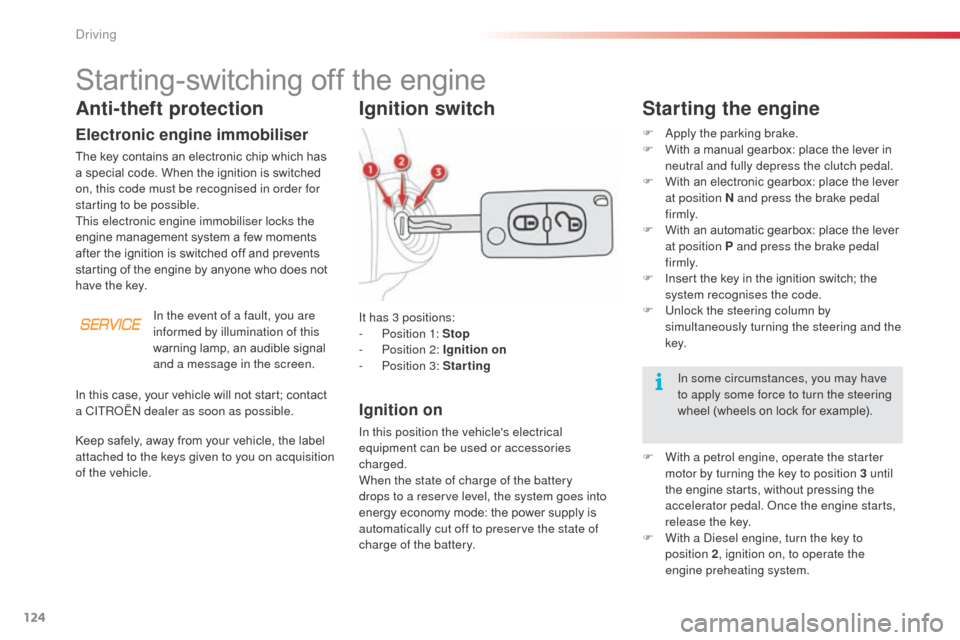
124
C3Picasso_en_Chap09_conduite_ed01-2015
Electronic engine immobiliser
The key contains an electronic chip which has
a special code. When the ignition is switched
on, this code must be recognised in order for
starting to be possible.
This electronic engine immobiliser locks the
engine management system a few moments
after the ignition is switched off and prevents
starting of the engine by anyone who does not
have the key.
Anti-theft protection
In the event of a fault, you are
informed by illumination of this
warning lamp, an audible signal
and a message in the screen.
Ignition switch
It has 3 positions:
- P osition 1: Stop
-
P
osition 2: Ignition on
-
P
osition 3: Starting
Ignition on
In this position the vehicle's electrical
equipment can be used or accessories
charged.
When the state of charge of the battery
drops to a reserve level, the system goes into
energy economy mode: the power supply is
automatically cut off to preserve the state of
charge of the battery.
Keep safely, away from your vehicle, the label
attached to the keys given to you on acquisition
of the vehicle. In this case, your vehicle will not start; contact
a CITROËN dealer as soon as possible.
Starting-switching off the engine
Starting the engine
F Apply the parking brake.
F
W ith a manual gearbox: place the lever in
neutral and fully depress the clutch pedal.
F
W
ith an electronic gearbox: place the lever
at position N and press the brake pedal
f i r m l y.
F
W
ith an automatic gearbox: place the lever
at position P and press the brake pedal
f i r m l y.
F
I
nsert the key in the ignition switch; the
system recognises the code.
F
U
nlock the steering column by
simultaneously turning the steering and the
key.
F
W
ith a petrol engine, operate the starter
motor by turning the key to position 3 until
the engine starts, without pressing the
accelerator pedal. Once the engine starts,
release the key.
F
W
ith a Diesel engine, turn the key to
position 2 , ignition on, to operate the
engine preheating system. In some circumstances, you may have
to apply some force to turn the steering
wheel (wheels on lock for example).
Driving
Page 128 of 292

126
C3Picasso_en_Chap09_conduite_ed01-2015
Parking brake
Applying
F Pull the parking brake lever fully up to immobilise your vehicle.
When the vehicle is being driven, if this
warning lamp and the STOP warning lamp
come on, accompanied by an audible signal
and a message in the multifunction screen,
this indicates that the parking brake is still
on or has not been properly released.
Releasing
F Pull the parking brake lever gently, press the release button then lower the lever
fully.
When parking on a slope, direct your
wheels against the pavement, apply the
parking brake and engage a gear.
When you leave the vehicle, take the
key with you and lock the vehicle.
Energy economy mode
After switching off the engine (position 1 - Stop
),
you can still use functions such as the audio
and telematic system, the wipers, dipped beam,
courtesy lamps, etc., for maximum cumulative
period of 30 minutes.
For more information, refer to the "Energy
economy mode" section.
Key reminder
If the key is left in the ignition switch, an
audible signal sounds when the driver's
door is opened.
Avoid attaching heavy objects to the
key, which would weigh down on its
blade in the ignition switch and could
cause a malfunction.
Driving
Page 133 of 292

131
C3Picasso_en_Chap09_conduite_ed01-2015
Gear shift indicator*
Operation
The system intervenes only when driving
economically.
Depending on the driving situation and your
vehicle's equipment, the system may advise
you to skip one or more gears. You can
follow this instruction without engaging the
intermediate gears.
The gear engagement recommendations must
not be considered compulsory. In fact, the
configuration of the road, the amount of traffic
and safety remain determining factors when
choosing the best gear. Therefore, the driver
remains responsible for deciding whether or not
to follow the advice given by the system.
This function cannot be deactivated.Example:
The information appears in the instrument
panel in the form of an arrow accompanied by
the suggested gear. -
Y
ou press the accelerator pedal
moderately.
- T he system may suggest that you engage
a higher gear, if appropriate. In the case of driving which makes
particular demands on the performance
of the engine (firm pressure on the
accelerator pedal, for example, when
overtaking...), the system will not
recommend a gear change.
The system never suggests:
-
e
ngaging first gear,
-
enga
ging reverse gear,
-
e
ngaging a lower gear.
System which reduces fuel consumption by advising the driver to change up.
* Depending on engine. -
Y
ou are in third gear.
With an electronic gearbox, the system
is only active in manual mode.
9
Driving
Page 134 of 292

132
C3Picasso_en_Chap09_conduite_ed01-2015
Hill start assist (with
electronic gearbox)
System which holds your vehicle temporarily
(approximately 2 seconds) when starting on a
slope, the time it takes to move your foot from
the brake pedal to the accelerator pedal.
This function is only active when:
-
t
he vehicle is completely stationary, with
your foot on the brake pedal,
-
c
ertain conditions on a slope are met,
-
w
ith the driver’s door closed.
The hill start assist function cannot be
deactivated. On an ascending slope, with the vehicle
stationary, the vehicle is held momentarily
when you release the brake pedal:
-
p
rovided you are in automated mode
(position A ) or in manual mode (position M )
with an electronic gearbox. On a descending slope, with the vehicle
stationary and reverse gear engaged, the
vehicle is held momentarily when you
release the brake pedal.
Operating fault
If a malfunction of the system occurs, these
warning lamps come on. Contact a CITROËN
dealer or a qualified workshop to have the
system checked.
Do not leave the vehicle while it is being
held in the hill start assist phase.
If you need to leave the vehicle with
the engine running, manually apply
the parking brake then ensure that the
parking brake warning lamp is on (not
flashing) in the instrument panel.
Operation
Driving
Page 136 of 292
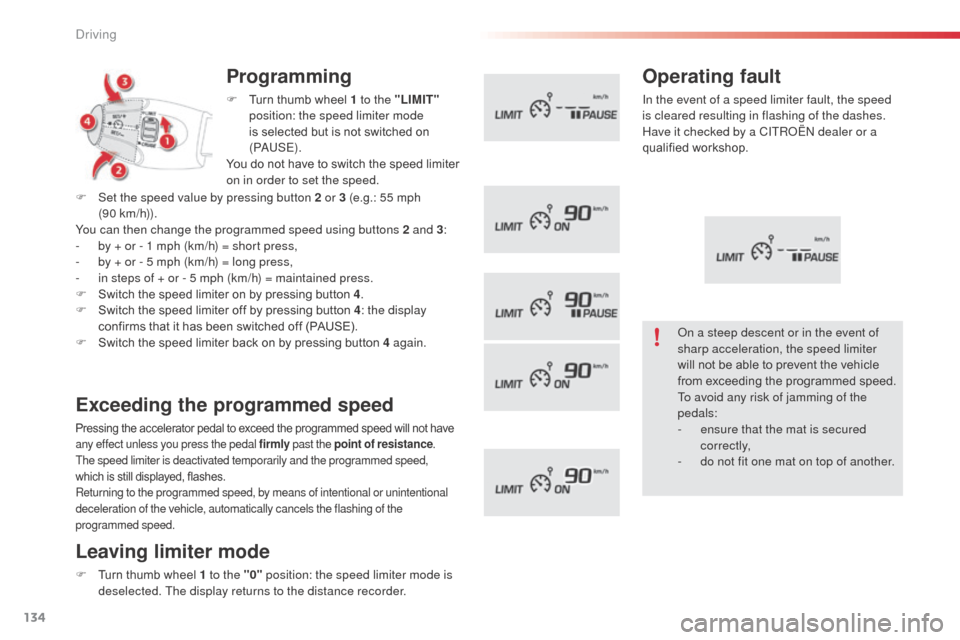
134
C3Picasso_en_Chap09_conduite_ed01-2015
Programming
F Turn thumb wheel 1 to the "LIMIT"
position: the speed limiter mode
is selected but is not switched on
(PAUS E).
You do not have to switch the speed limiter
on in order to set the speed.
Exceeding the programmed speed
Pressing the accelerator pedal to exceed the programmed speed will not have
any effect unless you press the pedal firmly past the point of resistance.
The speed limiter is deactivated temporarily and the programmed speed,
which is still displayed, flashes.
Returning to the programmed speed, by means of intentional or unintentional
deceleration of the vehicle, automatically cancels the flashing of the
programmed speed.
Leaving limiter mode
F Turn thumb wheel 1 to the "0" position: the speed limiter mode is
deselected. The display returns to the distance recorder.
Operating fault
In the event of a speed limiter fault, the speed
is cleared resulting in flashing of the dashes.
Have it checked by a CITROËN dealer or a
qualified workshop.
F
S
et the speed value by pressing button 2 or 3 (e.g.: 55 mph
(90
km/h)).
You can then change the programmed speed using buttons 2 and 3 :
-
b
y + or - 1 mph (km/h) = short press,
-
b
y + or - 5 mph (km/h) = long press,
-
i
n steps of + or - 5 mph (km/h) = maintained press.
F
S
witch the speed limiter on by pressing button 4 .
F
S
witch the speed limiter off by pressing button 4 : the display
confirms that it has been switched off (PAUSE).
F
S
witch the speed limiter back on by pressing button 4 again. On a steep descent or in the event of
sharp acceleration, the speed limiter
will not be able to prevent the vehicle
from exceeding the programmed speed.
To avoid any risk of jamming of the
pedals:
-
e
nsure that the mat is secured
c o r r e c t l y,
-
d
o not fit one mat on top of another.
Driving
Page 138 of 292
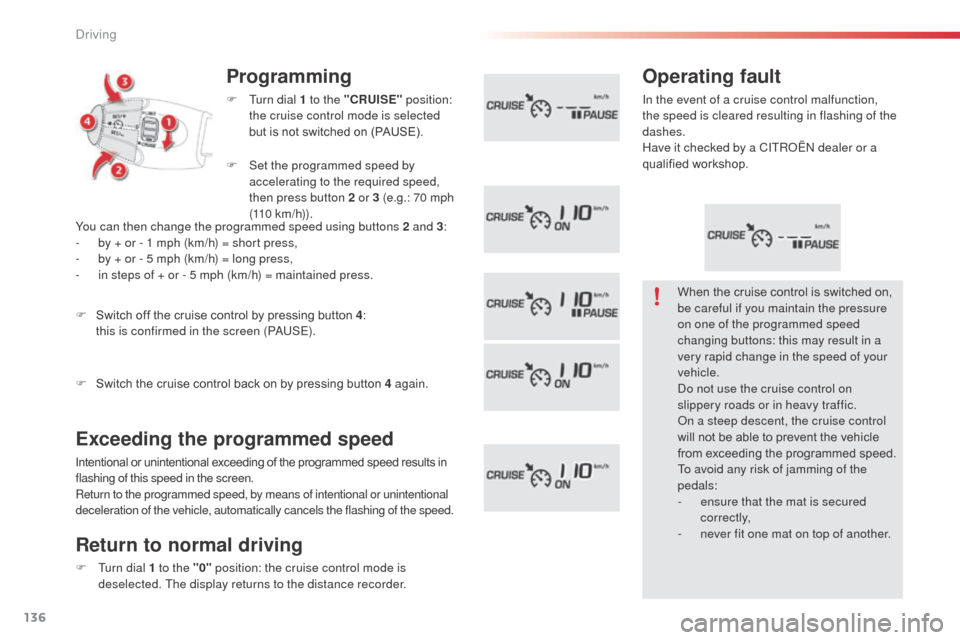
136
C3Picasso_en_Chap09_conduite_ed01-2015
Programming
F Turn dial 1 to the "CRUISE" position:
the cruise control mode is selected
but is not switched on (PAUSE).
Exceeding the programmed speed
Intentional or unintentional exceeding of the programmed speed results in
flashing of this speed in the screen.
Return to the programmed speed, by means of intentional or unintentional
deceleration of the vehicle, automatically cancels the flashing of the speed.
Return to normal driving
F Turn dial 1 to the "0" position: the cruise control mode is
deselected. The display returns to the distance recorder.
Operating fault
In the event of a cruise control malfunction,
the speed is cleared resulting in flashing of the
dashes.
Have it checked by a CITROËN dealer or a
qualified workshop.
F
S
et the programmed speed by
accelerating to the required speed,
then press button 2 or 3 (e.g.: 70 mph
(110 km/h)).
F
S
witch off the cruise control by pressing button 4 :
this is confirmed in the screen (PAUSE).
F
S
witch the cruise control back on by pressing button 4 again.
You can then change the programmed speed using buttons 2 and 3
:
-
b
y + or - 1 mph (km/h) = short press,
-
b
y + or - 5 mph (km/h) = long press,
-
i
n steps of + or - 5 mph (km/h) = maintained press. When the cruise control is switched on,
be careful if you maintain the pressure
on one of the programmed speed
changing buttons: this may result in a
very rapid change in the speed of your
vehicle.
Do not use the cruise control on
slippery roads or in heavy traffic.
On a steep descent, the cruise control
will not be able to prevent the vehicle
from exceeding the programmed speed.
To avoid any risk of jamming of the
pedals:
-
e
nsure that the mat is secured
c o r r e c t l y,
-
n
ever fit one mat on top of another.
Driving
Page 189 of 292
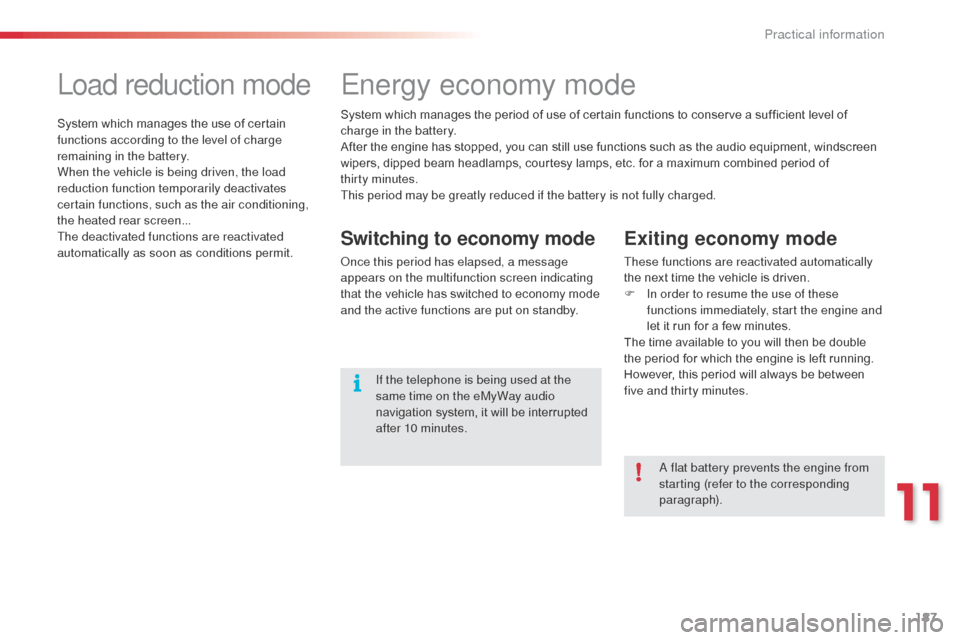
187
C3Picasso_en_Chap11_informations-pratiques_ed01-2015
Load reduction mode
System which manages the use of certain
functions according to the level of charge
remaining in the battery.
When the vehicle is being driven, the load
reduction function temporarily deactivates
certain functions, such as the air conditioning,
the heated rear screen...
The deactivated functions are reactivated
automatically as soon as conditions permit.
Energy economy mode
Exiting economy mode
These functions are reactivated automatically
the next time the vehicle is driven.
F
I
n order to resume the use of these
functions immediately, start the engine and
let it run for a few minutes.
The time available to you will then be double
the period for which the engine is left running.
However, this period will always be between
five and thirty minutes.
Switching to economy mode
Once this period has elapsed, a message
appears on the multifunction screen indicating
that the vehicle has switched to economy mode
and the active functions are put on standby.
A flat battery prevents the engine from
starting (refer to the corresponding
paragraph).
If the telephone is being used at the
same time on the eMyWay audio
navigation system, it will be interrupted
after 10 minutes.
System which manages the period of use of certain functions to conserve a sufficient level of
charge in the battery.
After the engine has stopped, you can still use functions such as the audio equipment,
windscreen
wipers, dipped beam headlamps, courtesy lamps, etc. for a maximum combined period of
thirty
minutes.
This period may be greatly reduced if the battery is not fully charged.
11
Practical information
Page 198 of 292
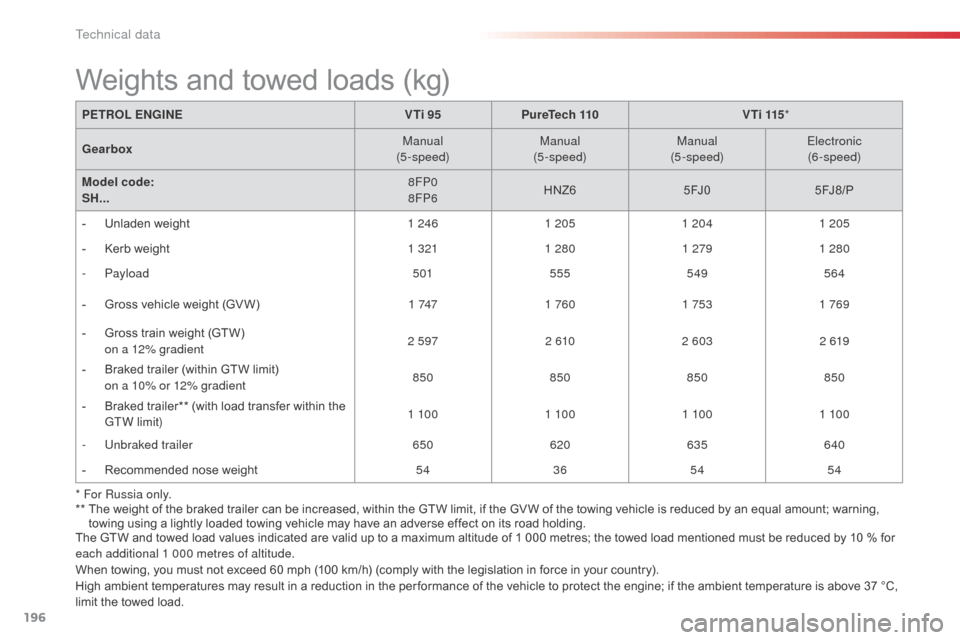
196
C3Picasso_en_Chap12_caracteristiques-techniques_ed01-2015
The GTW and towed load values indicated are valid up to a maximum altitude of 1 000 metres; the towed load mentioned must be reduced by 10 % for
each additional 1 000 metres of altitude.
When towing, you must not exceed 60 mph (100 km/h) (comply with the legislation in force in your country).
High ambient temperatures may result in a reduction in the per formance of the vehicle to protect the engine; if the ambient temperature is above 37 °C,
limit the towed load. * For Russia only.
**
T
he weight of the braked trailer can be increased, within the GTW limit, if the GV W of the towing vehicle is reduced by an equal amount; warning,
towing using a lightly loaded towing vehicle may have an adverse effect on its road holding.
PETROL ENGINE
VTi 95PureTech 110 V T i 115*
Gearbox Manual
(5-speed) Manual
(5-speed) Manual
(5-speed) Electronic
(6-speed)
Model code:
SH... 8FP0
8FP6
HNZ6
5 FJ 05 FJ 8 / P
-
U
nladen weight
1 2461 205 1 204 1 205
-
K
erb weight
1 3211 280 1 2791 280
-
Payload
501555 549564
-
G
ross vehicle weight (GV W)
1 7471 760 1 7531 769
-
G
ross train weight (GTW)
o
n a 12% gradient
2 597
2 6102 603 2 619
-
B
raked trailer (within GTW limit)
o
n a 10% or 12% gradient
850
850850850
-
B
raked trailer** (with load transfer within the
GTW limit) 1 10 0
1 10 01 10 01 10 0
-
U
nbraked trailer
650620635 640
-
R
ecommended nose weight
543654 54
Weights and towed loads (kg)
Technical data
Page 200 of 292

198
C3Picasso_en_Chap12_caracteristiques-techniques_ed01-2015
* The weight of the braked trailer can be increased, within the GTW limit, if the GV W of the towing vehicle is reduced by an equal amount; warning, towing using a lightly loaded towing vehicle may have an adverse effect on its road holding.
DIESEL ENGINE
BlueHDi 100
Gearbox Manual (5-speed)
Model code:
SH... BHY6
-
U
nladen weight
1 240
-
K
erb weight
1 315
-
Payload
560
-
G
ross vehicle weight (GV W)
1 800
-
G
ross train weight (GTW)
o
n a 12% gradient
2 700
-
B
raked trailer (within GTW limit)
o
n a 10% or 12% gradient
900
-
B
raked trailer* (with load transfer with the
GTW limit) 900
-
U
nbraked trailer
650
-
R
ecommended nose weight
36
The GTW and towed load values indicated are valid up to a maximum altitude of 1 000 metres; the towed load mentioned must be reduced by 10 % for
each additional 1 000 metres of altitude.
When towing you must not exceed 60 mph (100 km/h) (comply with the legislation in force in your country).
High ambient temperatures may result in a reduction in the per formance of the vehicle to protect the engine; if the ambient temperature is above 37 °C,
limit the towed load.
Weights and towed loads (kg)
Technical data